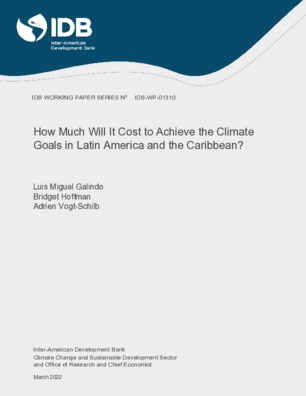How Much Will It Cost to Achieve the Climate Goals in Latin America and the Caribbean?
Date
Feb 2022
Latin America and the Caribbean must respond to the challenge of climate change while making progress with other sustainable development goals. How much will it cost to meet climate change goals in this context? This work reviews the evidence on the costs of meeting the goals the goals of the Paris Agreement and the sources of finance available to do so in the region.
Its main thesis is that climate action does not consist solely or primarily of additional spending, but also requires a massive redirection of existing financial flows. The climate goals cannot be achieved without addressing other sustainable development goals intrinsically related to climate, such as those related to energy, transportation, water, agriculture, and ecosystem conservation, among others. Furthermore, climate action is closely linked to social spending since social conditions such as poverty, inequality, and lack of access to basic health services exacerbate vulnerability to climate change. Finally, the transition to a decarbonized and resilient economy must be fair. A so-called just transition means maximizing socioeconomic benefits, minimizing, or compensating transition costs, and involving all affected parties in decision-making processes. Consequently, climate action is also linked to competitiveness, education levels, labor markets, and social institutions.
We find that responding to the climate crisis requires annual spending on the provision of infrastructure services of between 2% to 8% of GDP and annual spending to address a variety of social challenges of between 5% and 11% of GDP. This will involve aligning in total from 7% to 19% of annual GDP, representing from US$470 billion to US$1,300 billion of infrastructure and social spending in 2030, with sustainable, resilient, and decarbonized development goals. The benefit of this redirection will be far greater than its costs because it will avoid the worst impacts of climate change and generate economic, social, fiscal, and environmental benefits.
Specific financing sources, such as green taxes and sustainable bonds, can finance part of the effort. However, to redirect public and private spending and foreign investment into solutions consistent with climate goals, governments will also need to reform policies and regulations in all sectors. Comprehensive climate strategies can help identify the necessary transformations to move toward a resilient, carbon-neutral economy in the region by 2050. Development banks can directly finance a small part of the necessary spending and support the design and implementation of reforms to redirect existing financial flows.
Its main thesis is that climate action does not consist solely or primarily of additional spending, but also requires a massive redirection of existing financial flows. The climate goals cannot be achieved without addressing other sustainable development goals intrinsically related to climate, such as those related to energy, transportation, water, agriculture, and ecosystem conservation, among others. Furthermore, climate action is closely linked to social spending since social conditions such as poverty, inequality, and lack of access to basic health services exacerbate vulnerability to climate change. Finally, the transition to a decarbonized and resilient economy must be fair. A so-called just transition means maximizing socioeconomic benefits, minimizing, or compensating transition costs, and involving all affected parties in decision-making processes. Consequently, climate action is also linked to competitiveness, education levels, labor markets, and social institutions.
We find that responding to the climate crisis requires annual spending on the provision of infrastructure services of between 2% to 8% of GDP and annual spending to address a variety of social challenges of between 5% and 11% of GDP. This will involve aligning in total from 7% to 19% of annual GDP, representing from US$470 billion to US$1,300 billion of infrastructure and social spending in 2030, with sustainable, resilient, and decarbonized development goals. The benefit of this redirection will be far greater than its costs because it will avoid the worst impacts of climate change and generate economic, social, fiscal, and environmental benefits.
Specific financing sources, such as green taxes and sustainable bonds, can finance part of the effort. However, to redirect public and private spending and foreign investment into solutions consistent with climate goals, governments will also need to reform policies and regulations in all sectors. Comprehensive climate strategies can help identify the necessary transformations to move toward a resilient, carbon-neutral economy in the region by 2050. Development banks can directly finance a small part of the necessary spending and support the design and implementation of reforms to redirect existing financial flows.




